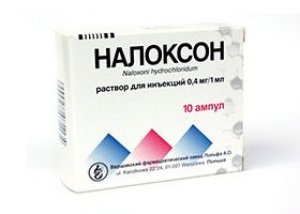
All iLive content is medically reviewed or fact checked to ensure as much factual accuracy as possible.
We have strict sourcing guidelines and only link to reputable media sites, academic research institutions and, whenever possible, medically peer reviewed studies. Note that the numbers in parentheses ([1], [2], etc.) are clickable links to these studies.
If you feel that any of our content is inaccurate, out-of-date, or otherwise questionable, please select it and press Ctrl + Enter.
Naloxone
Medical expert of the article
Last reviewed: 03.07.2025

ATC classification
Active ingredients
Pharmacological group
Pharmachologic effect
Indications Naloxone
It is indicated mainly for the treatment of acute poisoning with opiate painkillers. In addition, it can be used in the case of a person developing a coma caused by alcohol, and at the same time in various types of shock (such an effect is associated with the fact that in the case of the development of certain types of stress or shock, the opioid system of the human body is activated, and in addition to this, also with the fact that Naloxone can contribute to an increase in low blood pressure).
Since the medicinal effect of the substance is short-lived, this limits the possibility of using it in the treatment of drug addiction.
Pharmacokinetics
In case of intravenous administration of the drug, its effect begins already in the first 2 minutes, and with subcutaneous or intramuscular injection - after several minutes. The duration of the drug's effect after intravenous injection is 20-45 minutes, and after subcutaneous or intramuscular injection - 2.5-3 hours.
The half-life is approximately 1 hour. Metabolism occurs in the liver and excretion occurs via the kidneys.
Dosing and administration
The medicine should be administered intravenously (do this slowly: 2-3 minutes), as well as subcutaneously or intramuscularly.
In case of intoxication with narcotic painkillers, the initial dosage is 0.4 mg. If necessary, this dose should be administered repeatedly, maintaining intervals of 3-5 minutes, until spontaneous breathing is restored and the patient regains consciousness. The maximum dosage is 10 mg. The initial pediatric dosage is 0.005-0.01 mg/kg.
To speed up recovery from anesthesia used in surgical operations, an injection of 0.1-0.2 mg (approximately 1.5-3 mcg/kg) is required at intervals of 2-3 minutes. The procedure should be performed until the required pulmonary ventilation appears and the patient regains consciousness. The pediatric dose is an intravenous injection of 0.001-0.002 mg/kg, and if this does not bring results, repeat doses of up to 0.1 mg/kg should be administered at intervals of 2 minutes (until consciousness is restored and spontaneous breathing begins). If intravenous administration is not possible, a subcutaneous or intramuscular injection is required. For newborns, the initial dosage is 0.01 mg/kg.
In case of respiratory depression in newborns, which developed due to the administration of opiate painkillers during childbirth, an injection of 0.1 mg/kg of the drug is required (by intravenous, intramuscular or subcutaneous route). In the future, it is permitted to administer the drug intramuscularly in the amount of 0.2 mg (or 0.06 mg/kg) as a preventive measure.
To diagnose a patient with opioid addiction, 0.8 mg of the drug must be administered intravenously.
Use Naloxone during pregnancy
Pregnant women are prohibited from prescribing the medicine. Also, you cannot breastfeed your child while using the solution.
Side effects Naloxone
The introduction of the solution may cause the following side effects:
- sensory organs, as well as the nervous system: development of convulsions or severe tremors;
- organs of the cardiovascular system, as well as the processes of hemostasis and hematopoiesis: development of tachycardia, increased blood pressure and cardiac arrest;
- gastrointestinal tract: the appearance of vomiting, as well as nausea;
- others: development of hyperhidrosis.
Interactions with other drugs
Naloxone weakens the antihypertensive properties of clonidine.
The drug weakens the effect of opiate painkillers (this list includes drugs such as nalbuphine, fentanyl, butorphanol, as well as pentazocine with remifentanil) and at the same time accelerates the development of withdrawal syndrome in the patient.
The drug is incompatible with medicinal solutions containing hydrosulfates.
It has pharmaceutical compatibility with sodium chloride solution (0.9%), as well as dextrose (5%), and also with sterile injection water.
 [ 28 ]
[ 28 ]
Storage conditions
The solution should be kept in a place protected from sunlight and out of reach of children. Temperature values are within 15-25°C.
 [ 29 ]
[ 29 ]
Shelf life
Naloxone can be used for a period of 4 years from the date of release of the medicinal solution.
 [ 30 ]
[ 30 ]
Manufacturer
Attention!
To simplify the perception of information, this instruction for use of the drug "Naloxone" translated and presented in a special form on the basis of the official instructions for medical use of the drug. Before use read the annotation that came directly to medicines.
Description provided for informational purposes and is not a guide to self-healing. The need for this drug, the purpose of the treatment regimen, methods and dose of the drug is determined solely by the attending physician. Self-medication is dangerous for your health.

